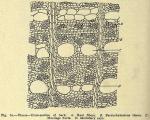 The dried bark of Ul'mus ful'va Michaux (Fam. transferred to Ulmaceae—U. S. P. 1900), deprived of its periderm.
The dried bark of Ul'mus ful'va Michaux (Fam. transferred to Ulmaceae—U. S. P. 1900), deprived of its periderm.
BOTANICAL CHARACTERISTICS. A tree 40 to 60 feet high. Leaves ovate-oblong, taper-pointed, doubly serrate, very rough above. Flowers nearly sessile, in lateral clusters, purplish or brownish. Fruit a 1-celled, 1-seeded samara, winged all around.
HABITAT.—North America, north of the Carolinas and east of Nebraska.
 DESCRIPTION OF DRUG.—Various sized flat pieces about 4 mm. (1/6 in.) thick deprived of cork, of a uniformly pale brownish-white color, the finely ridged inner surface with a slight reddish tinge; good specimens are tough and flexible, capable of being bent double. The texture consists of soft parenchymatous tissue with tangentially arranged bast fibers and numerous medullary rays, giving to a cross. section of the bark a delicately checkered appearance. Odor agreeable, resembling fenugreek. Taste highly mucilaginous. It yields a fawn-colored powder which is often adulterated with starch. European elm bark, from U. campestris and U. effusa, cinnamon-colored, nearly inodorous, mucilaginous, but has a bitterish and astringent taste, owing to the presence of a little tannin. A few nearly spherical starch grains (0.005 to 0.01 µ in diameter) are sometimes present.
DESCRIPTION OF DRUG.—Various sized flat pieces about 4 mm. (1/6 in.) thick deprived of cork, of a uniformly pale brownish-white color, the finely ridged inner surface with a slight reddish tinge; good specimens are tough and flexible, capable of being bent double. The texture consists of soft parenchymatous tissue with tangentially arranged bast fibers and numerous medullary rays, giving to a cross. section of the bark a delicately checkered appearance. Odor agreeable, resembling fenugreek. Taste highly mucilaginous. It yields a fawn-colored powder which is often adulterated with starch. European elm bark, from U. campestris and U. effusa, cinnamon-colored, nearly inodorous, mucilaginous, but has a bitterish and astringent taste, owing to the presence of a little tannin. A few nearly spherical starch grains (0.005 to 0.01 µ in diameter) are sometimes present.
Powder.—Characteristic elements: See Part iv, Chap. I, B.
CONSTITUENTS.—A large quantity of mucilage (capable of precipitation with alcohol and lead acetate), and some tannin.
ACTION AND USES.—Demulcent—externally as an emollient application, in poultice. Dose: 2 dr. (8 Gm.) or more.

